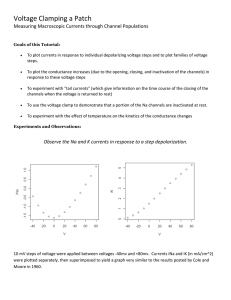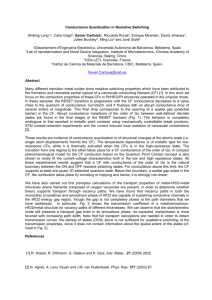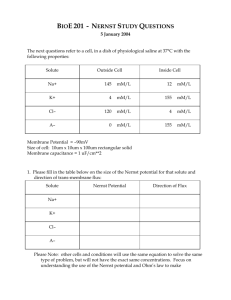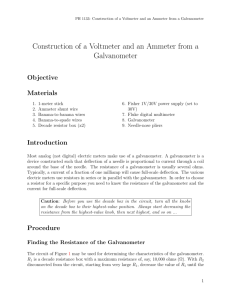AP 103- 3: Conduction by students
advertisement
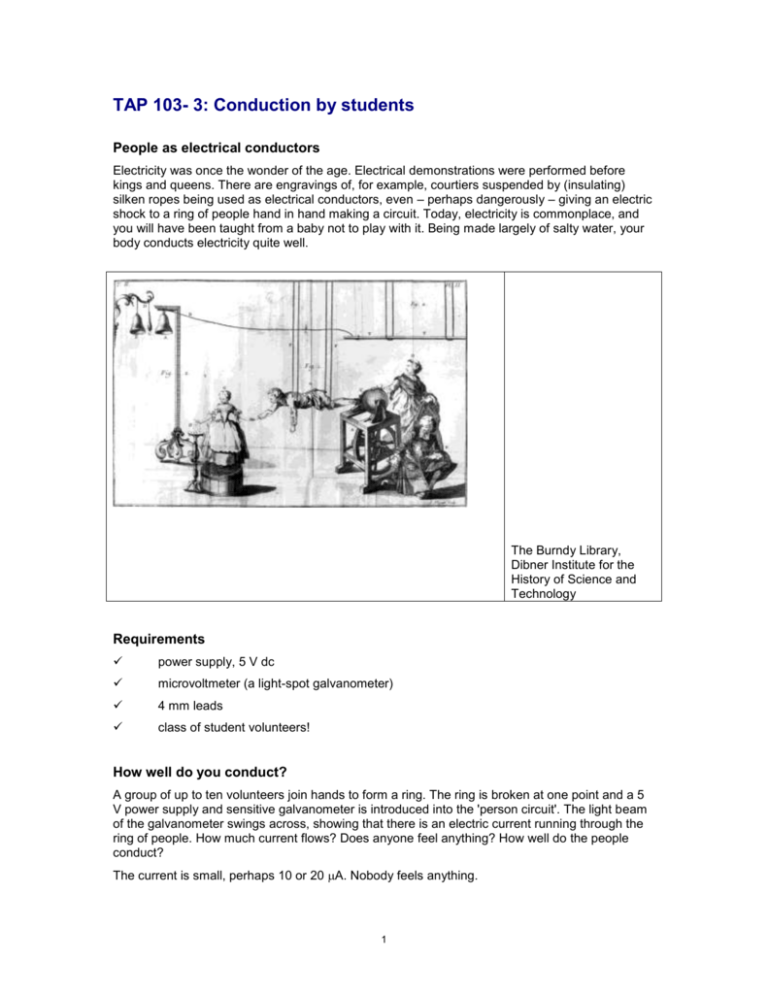
TAP 103- 3: Conduction by students People as electrical conductors Electricity was once the wonder of the age. Electrical demonstrations were performed before kings and queens. There are engravings of, for example, courtiers suspended by (insulating) silken ropes being used as electrical conductors, even – perhaps dangerously – giving an electric shock to a ring of people hand in hand making a circuit. Today, electricity is commonplace, and you will have been taught from a baby not to play with it. Being made largely of salty water, your body conducts electricity quite well. The Burndy Library, Dibner Institute for the History of Science and Technology Requirements power supply, 5 V dc microvoltmeter (a light-spot galvanometer) 4 mm leads class of student volunteers! How well do you conduct? A group of up to ten volunteers join hands to form a ring. The ring is broken at one point and a 5 V power supply and sensitive galvanometer is introduced into the 'person circuit'. The light beam of the galvanometer swings across, showing that there is an electric current running through the ring of people. How much current flows? Does anyone feel anything? How well do the people conduct? The current is small, perhaps 10 or 20 A. Nobody feels anything. 1 Try one volunteer only. The current is larger, perhaps 100 to 200 A. The person still feels nothing (usually - some people can just detect currents at this level). Danger or not? Torch batteries are not dangerous because although they can produce relatively large currents (in low resistance circuits) they do so at safe low potential differences, and only a small current actually flows through the body. An electrostatic generator like the Van de Graaff (or like your shoes scuffing a nylon carpet) is not dangerous because it only produces a harmlessly small current even though at a very high potential difference. It is the combination of potential difference large enough and a source resistance small enough to make the human body conduct substantial currents that matters. Potential differences up to about 30 V are thought to be safe enough. Beyond that high tension supplies of 100 V or more, or EHT supplies of 1 kV or more, can be lethal if the current supplied is sufficient. Currents of a few microamps are not felt. Those around 1 mA are uncomfortable for the average human, but not lethal. Once several milliamps or more are conducted, especially if near the heart, then cardiac arrest or fibrillation (irregular heart muscle activity) can result. The conductance of the body is largely dependent on the state of the skin and pores, being high if they are wet or sweaty. It is for this reason that light switches are usually placed outside bathrooms, or if inside, are operated by an insulating cord. The body fluids inside the skin are quite good conductors due to their ion content, and if the skin resistance is breached by sparking, substantial currents can flow through the body. Outcomes Your body conducts electric current, a few tens of microampere for each volt of potential difference across it. So for 1000 V the current reaches tens of milliamperes (if the source can supply it), which is big enough to be lethal. But your resistance can vary a lot – people have been killed by just over 50 V; 230 V kills regularly. Practical advice Here we demonstrate that students conduct electric current, albeit in small quantities if the voltage supply is low. Conductance can be defined, measured and compared to the more familiar reciprocal quantity resistance. This is intended to be a straightforward, quick, fun demonstration to introduce conductance. Make a series circuit with all the (willing) students clasping hands, a 5 V dc power supply and the galvanometer, measuring the unfelt current around the complete loop. The current will depend on many factors including dryness of students' skin. Typically for a ring of ten students currents are around tens of μA, so the galvanometer will need to be set at an appropriate sensitivity. To calculate the total conductance, divide the current by the potential difference. To calculate the conductance of per student, first divide the potential difference by the number of students. Typical values for one person are about 30 k or 33 mS. If any pair of hands breaks contact the conductance falls swiftly to zero and so does the current. Students enjoy the effect of this on the light beam galvanometer, which is easier to observe in a partially darkened lab. Individual conductances can be measured, and are the basis for some lie detector tests (if you sweat when you lie)! Students may be surprised that they cannot detect currents at this level, and useful discussion about electric shocks, cardiac arrest, fibrillation and defibrillation can follow. The variable contact conductance and the possible excitement of the students mean that their 2 conductances are not constant enough to perform the obvious follow up. This would be to connect students in parallel and show that their conductances add, although it might be fun to try. This would have to be demonstrated with fixed conductors. It is worth reminding students that the energy of chemical reactions and cells is relatively modest, being typically 150 kJ per mole. This translates to a few electron volts (eV) per electron. So the potential energy per coulomb for typical chemical cells is 1 or 2 volts. Cells give electrons a rather low energy, but can produce substantial flows of charge by reacting chemicals in largish numbers of atoms per second. If a cell produces a current of 0.2 A it produces n = I / e = 0.2 A / 1.6 × 10–19 C = 1.3 × 1018 electrons per second. This is a very large number, but is only a small fraction of a mole, so cells can produce quite large charge flows over substantial times before their chemicals are all reacted. Alternative approaches A more formal class practical could be run using resistance substitution boxes and a digital multimeter and calculator to bring out the relationships between conductance and resistance. Social and human context Electric shock, danger from high voltages including the mains. The importance of current level on severity of shock. Cardiac arrest and fibrillation and the process of defibrillation. The morality of using electric shock 'therapy' in dealing with the mentally disturbed. External Reference: SATIS 16–19 Unit 25, Why 50 Hz? Be safe Again you need to be aware of any medical reasons why it would be inadvisable to allow these very small currents to pass through the students in your care. Reasons might include heart irregularities and a tendency to epilepsy. External references This activity is taken from Advancing Physics Chapter 2, 60E 3




